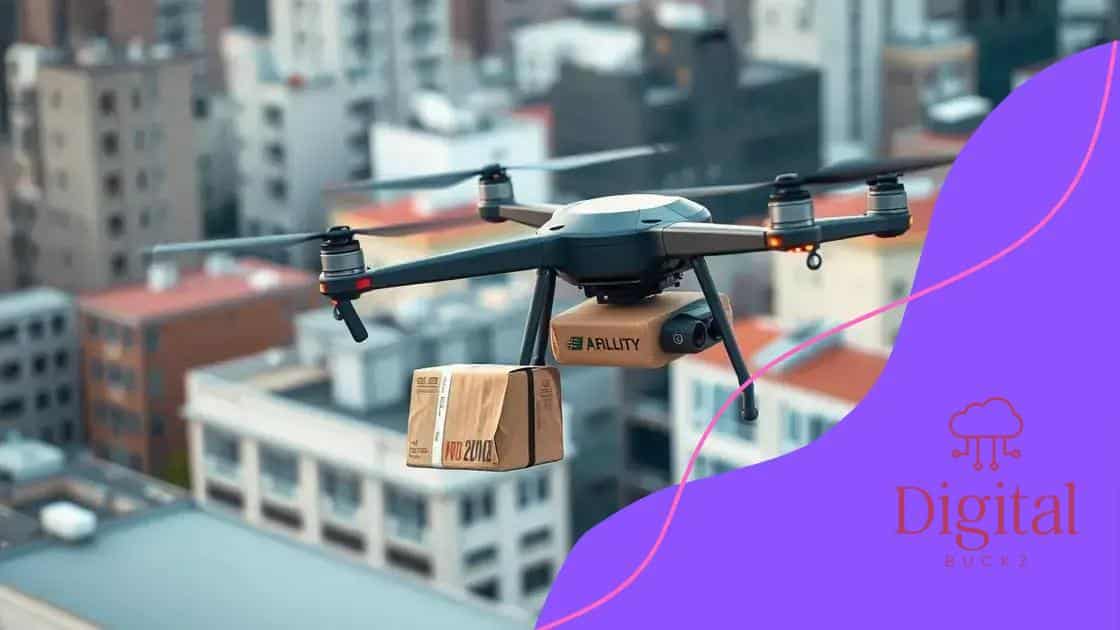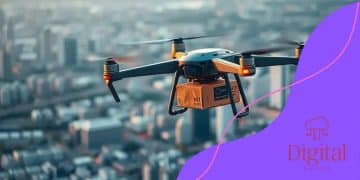The role of drones in delivery services worldwide

The role of drones in delivery services worldwide is revolutionizing logistics by providing fast, cost-effective, and efficient solutions, while overcoming challenges such as regulations and safety concerns.
The role of drones in delivery services worldwide is becoming increasingly relevant as businesses look for faster, more efficient solutions. Have you ever wondered how these flying robots can transform your shopping experience?
Overview of drone technology in delivery services
The overview of drone technology in delivery services reveals advancements that are quickly influencing how goods are transported. Drones are not just a novelty anymore; they are becoming a practical solution for businesses looking to improve their delivery systems.
How Drones Work in Deliveries
Drones utilize GPS and autopilot technology to navigate through various terrains. They can carry packages directly to customers, allowing for faster delivery times. This innovation is particularly beneficial for remote areas where traditional delivery methods are challenging.
Benefits of Implementing Drones
Integrating drone technology has several advantages for businesses. Here are some key points:
- Increased delivery speed
- Reduction in shipping costs
- Ability to reach difficult locations
- Minimal environmental impact compared to traditional vehicles
Another critical aspect is the real-time tracking that drones offer. Customers can monitor their packages from dispatch to delivery, enhancing their overall experience. This transparency builds trust and reliability in the delivery process.
Despite these benefits, businesses must also consider some challenges. Regulatory restrictions can impact how and where drones operate. Additionally, ensuring the safety and privacy of individuals is paramount as drone deliveries become more common.
The future of drone technology in delivery services looks promising. As regulations evolve and technology improves, we can expect to see a surge in the use of drones for various products. From food to medical supplies, the possibilities are endless for enhancing logistics and meeting customer needs.
Benefits of using drones for deliveries
The benefits of using drones for deliveries are significant and can transform the logistics landscape. Companies are discovering new ways to improve their operations while satisfying customer demands more effectively.
Speed and Efficiency
One of the most notable advantages is the speed of delivery. Drones can navigate directly to their destinations without the delays often caused by traffic. This means customers receive their orders faster than traditional delivery methods.
Cost Savings
Businesses can also save money by using drones for deliveries. Here are some of the cost-effective benefits:
- Reduction in fuel costs
- Lower labor expenses
- Minimized wear and tear on vehicles
- Shorter delivery times leading to higher efficiency
Another major benefit is the ability to reach remote or hard-to-access locations. Drones can easily deliver packages in rural areas or places with challenging terrains, which traditional delivery vehicles may struggle to access. This opens up opportunities for companies to expand their services.
Furthermore, drones contribute to a reduced carbon footprint when compared to traditional delivery vehicles. By harnessing electric power, they help decrease overall greenhouse gas emissions.
Additionally, the integration of drone delivery can enhance customer satisfaction. Real-time tracking features allow customers to monitor their packages, giving them assurance and visibility throughout the delivery process.
Incorporating drones into the supply chain presents a futuristic approach that aligns with today’s fast-paced consumer expectations. As these technologies continue to develop, businesses that leverage drone deliveries will likely gain a competitive edge in their respective markets.
Challenges faced by drone delivery systems

The challenges faced by drone delivery systems are significant and can affect how this technology evolves. While drones offer many benefits, there are hurdles that need addressing to ensure safe and effective operations.
Regulatory Issues
One major challenge is navigating complex regulations set by government agencies. Each country has its own set of rules for drone operations, which can make it difficult for companies to implement standardized delivery systems. Compliance is crucial for safety and public acceptance.
Safety Concerns
Ensuring the safety of both the drones and the public is paramount. Drones can malfunction or cause accidents. Here are some specific safety challenges:
- Potential collisions with other aircraft
- Risk of crashing into buildings or people
- Technical failures during flight
- Data privacy concerns for surveillance
Another concern is the technological limitations of drones themselves. Factors such as battery life and payload capacity can restrict the range and efficiency of delivery. Additionally, adverse weather conditions like strong winds or heavy rain can hinder drone performance. This unpredictability can affect delivery schedules.
Public perception also plays a critical role in the adoption of drone delivery. Some individuals may feel uncomfortable with drones flying overhead, fearing privacy invasion or noise pollution. Addressing these concerns requires community engagement and transparent communication about the benefits and safety measures in place.
Additionally, integrating drones into existing logistics systems presents challenges. Companies must think about how to manage routes, coordinate with ground delivery options, and optimize their operations to include drones efficiently.
Case studies of successful drone delivery
The case studies of successful drone delivery highlight real-world examples where this technology has made a positive impact. These stories help us understand how businesses are utilizing drones to enhance their delivery systems.
Amazon Prime Air
One of the most well-known examples is Amazon Prime Air. The company has been testing drone deliveries in various locations. In one notable case, a customer ordered a small package, and within 30 minutes, a drone delivered it right to their backyard. This demonstration showcased the speed and efficiency of using drones for home deliveries.
UPS Flight Forward
Another successful case is UPS Flight Forward. They have launched drone deliveries for medical supplies. In a partnership with a healthcare provider, UPS was able to deliver critical medications to a hospital in a rural area. The use of drones reduced delivery times significantly, which is crucial in medical emergencies.
Zipline
Zipline has made headlines with its operations in several African countries. The company specializes in delivering medical products to remote areas, where access to healthcare can be challenging. By using drones, Zipline has been able to deliver blood and vaccines quickly, saving lives and improving healthcare access.
These case studies demonstrate how drone delivery is not only possible but also effective. Each example highlights unique ways that companies are addressing challenges and improving logistics. As these innovations continue, we can expect more industries to adopt drone technology in their delivery systems.
Future trends in drone delivery services
The future trends in drone delivery services indicate exciting advancements that could reshape the entire logistics industry. As technology evolves, so does the potential for these aerial vehicles to be integrated into daily life.
Increased Autonomy
One key trend is the movement towards greater autonomy. With improvements in artificial intelligence and machine learning, drones are becoming smarter. They will be able to make decisions on their own, such as avoiding obstacles and selecting optimal flight paths. This autonomy can enhance delivery efficiency and reduce the need for human intervention.
Expanded Delivery Range
Another significant trend is the expansion of delivery range. Companies are developing drones that can fly longer distances without needing to recharge. This advancement means deliveries can reach places that were previously hard to access, like remote villages or rural areas.
- Improved battery technology will increase flight times.
- Collaboration with other transportation methods will create seamless delivery systems.
- Integration of drones into existing logistics networks will optimize routes.
Additionally, regulations are expected to evolve, allowing for more flexible drone operations. As governments become more familiar with this technology, they are likely to introduce frameworks that facilitate its growth. This can lead to the establishment of drone delivery corridors, similar to the air traffic systems we have today.
Moreover, the use of drones is expected to expand beyond just package delivery. Industries such as agriculture, emergency services, and construction are looking at how drones can play a role in their operations. For instance, drones might be used for aerial surveillance in farming or to deliver medical supplies in urgent situations.
As the technology matures, public acceptance will also grow. With awareness about the benefits and safety measures in place, more people will embrace drones as a standard aspect of delivery services. This acceptance will pave the way for broader adoption in various sectors.
FAQ – Frequently Asked Questions about Drone Delivery Services
What are the main benefits of using drones for deliveries?
Drones offer fast delivery times, cost savings, and the ability to reach remote areas, improving overall logistics.
What challenges do drone delivery services face?
Key challenges include regulatory issues, safety concerns, and technological limitations that need to be addressed for effective implementation.
How do drones enhance customer experience in delivery?
Drones provide real-time tracking and fast delivery, giving customers visibility and increasing satisfaction with the service.
What future trends can we expect in drone delivery services?
Future trends include increased autonomy, expanded delivery ranges, and broader adoption across various industries as technology evolves.






